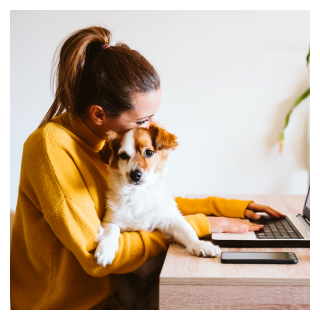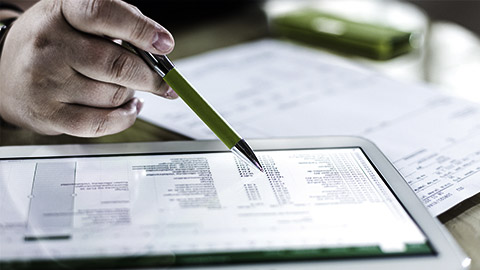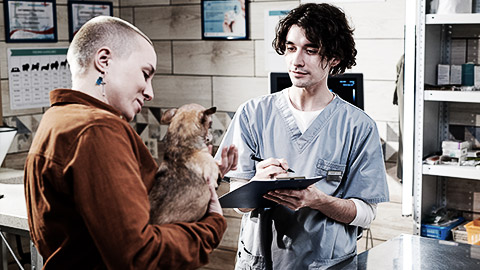At the start of each day that you work in your reception area, you will receive communication from clients, new/possible clients, suppliers and other clinics of facilities. This communication can either be:

Telephone call


E-mails
You will need to consider the urgency of each communication before passing them on. Where communications are urgent, they should be passed on immediately. Where they are not so urgent, they can wait until later in the day.
No matter what the communication is, your job will be to processes the communication this could be by taking messages, handing the mail to or forwarding the email to the relevant person.
Appropriate telephone communication techniques used when providing reception services
Talking with a customer/client on the phone can often be a difficult task. Without seeing an individual’s face, messages can become muddled, and meanings misinterpreted.
To improve your telephone communication skills, be sure to master the following tips:
- Adopt a Positive Tone
- Clear Enunciation
- Loud and clear voice
- Be Sincere
- Use Their Name
Maintain information and records system to ensure integrity
It is vital to the facility that the information and records system is maintained to ensure integrity:
Information and records system may include:
- Business information:
- Animal admission and discharge information
- Breeding records
- Boarding or agistment records and diets
- Client newsletters
- Products, equipment and disposables stocktake
- Product and service charges
- Suppliers contact information
- Training plans and individual animal progress
- Client information:
- Information and advice on breeding, diet and health
- Care, housing, training and exercise needs of specific animals
- Need for specialised or technical assistance
- Range of products and services available
There are three types of information that might be included in or added to client records. These include:
- Animal identification
- Animal health information
- Owner information
Integrity of records

What does integrity mean?
Integrity means that records are complete and authentic. It requires that all the components of the records are present, in the correct order.
How do we ensure the integrity of records?
- Ensure records provide adequate evidence of the conduct of business to account for that conduct
- Ensure that records are what they purport to be and that their purported creators have indeed created them — so they are authentic
- Ensure records contain all the content, structural and contextual information necessary to document transactions — so they are complete
- Ensure that records comply with recordkeeping requirements arising from the regulatory and accountability environment in which the organisation operates
- Ensure that records are comprehensive and document the complete range of the organisation’s activity
Remember:
- Adequate records need to be consciously created and maintained to ensure full accountability
- Authentic records may require signatures, digital signatures or other forms of verification
- Complete records require metadata relating to creators, technical or manual systems, data regarding use over time
- Compliant records require documentation of legislation, regulations and internal procedures which can be retained with the records
- Comprehensive records may require hybrid recordkeeping systems over time

Office equipment and software packages typically used in an animal care facility
Working in the reception area, you will use a number of different pieces of equipment. The types of equipment you might find in the reception area of an animal care facility might include:
- Cash register
- Computer and associated software and hardware:
- Email and social networking software used for business promotion and communication
- Office sales software
- Printer, scanner and modem operation
- Word processing, database and spreadsheet functions
- Client management software
- Veterinary management software
- Photocopier
- Staff communication systems (e.g., Two-way radio and intercom)
- Telephone
- EFTPOS machines
Some clinics may also have a product scanner, to scan the product for pricing when a customer buys the product, also a label printer to print customer and drug labels for customers
Desktop Computer
This is used to enter client booking times into various programs, as well as, updating an animal’s weight, updating their history and clients (contact) details.
You will also use the computer to make up accounts and invoices for clients, open and answer emails, look up histories of pets and clients and email them to other facilities as required.
Also, use the computer to start a customer’s application for a service such as Vet Pay.
Printer
Printers are used to print of patient histories, invoices, prescription etc.…
Telephone system
The telephone system is used to receive calls from clients to make bookings, or to make prescription requests. The telephone is also used for people calling to ask about prices on services or products and making bookings or appointments.
In some cases, the phone is also used for contacting suppliers for deliveries, as well as a range of other enquiries for the clinic.
EFTPOS
EFTPOS is used for completing invoice/payment transactions and purchases from a retail perspective.
Cash register
The cash register is where the cash takings and the EFTPOS slips are held until the close of business.
At the start of the day, the cash register contains the float, which in most facilities would be $180.00 in multiple denominations. At the end of the day, the float is taken out, and the cash that is remaining is the cash takings for the day. This is the reconciled with the invoices to ensure the correct money and EFTPOS dockets are in the cash drawer.

It is important that you make sure that when you are creating an invoice that you choose the right client to bill, as well as the right product or service listed, as this could alter the billing dramatically and thereby affect the stock level. For example: If you had a client come in and buy a 2 kilo bag of Royal Canin Feline stage 2 senior, and it is marked as $29.50 and put it on the invoice as stage 1 which is $26.50 then your facility is not only going to be out by $3.00 for that product (which might not seem like much for that item but over the day is a lot) but the stocktake will also be out.
It is also important that you find out what your facilities fee structure is for each of the services and /or products. As discussed in topic 1 you should obtain a price list for the main services and products that your facility provides; you can also read the policies and procedures on the Fee Structure.
Most facilities will have the fees listed on their accounting system (such as Vet Link) this will give the list of the Services/products along with the cost price and the recommended retail price. If you have any queries about the price of a service or product, you should always ask your supervisor or manager.
Invoice or receipt services and products in line with workplace fee structure
It is important that the facilities cash control is monitored, and basic financial documents prepared. Basic financial documents may include:
- Cash register daily total
- Credit card payments summary
- Invoice for services and products
- Receipt of payment by client
What is cash control?
Cash control is a process that is used to verify the complete nature and accurate recording of all cash that is received, as well as any cash disbursements that take place. As a broad principle of responsible financial accounting, this process will take place in your facility where products and services are sold to your client’s.
Procedure for cash control

Each veterinary clinic/hospital/animal care facility will have their own way of controlling and monitoring cash control and preparing financial documentation; these documents may include
- Invoices
- Estimates
- EFTPOS receipts
- End of day summaries
- Start of day:
- Check that your EFTPOS roll is full
- Collect, count and place into cash register your float ($180.00)
- During shift:
- Any cash received:
- Count the cash and place it beside cash register
- If required count change and hand it to the customer
- Place the cash into the cash register
- Any EFTPOS, print off merchant copy
- Write the name of client on the slip
- Circle the amount paid
- Circle the approved text
- Initial the slip
- Place the slip into the cash register
- Print off a customer copy
- Print the paid invoice
- Staple invoice and customer copy of EFTPOS together and hand it to the customer
- Any cash received:
- End of Shift:
- Count the float and separate the coins into a coin bag
- Count the cash taking and place into a separate cash bag
- On your booking system for example on Vet Link
- Select “Utilities”
- Select “End of period”
- Select “Start end of Day”
- Select print reports
- Whilst the reports are being printed, go to your EFTPOS machine:
- Press enter
- Select settlement
- Select subtotal
- Press enter
- When print out is finished tear it off
- Go to the computer and in each of the cash and EFTPOS columns:
- Enter in the adjusted amount into each column
- Press complete
- Press close
The total amount for the day will be printed out, and this is then placed in accounts area, and the cash is placed into the safe for checking the next working day.

Stock should be periodically monitored to ensure that the integrity of the stock is maintained and that you are not running out of stock or using out of date stock. It is also important that you make sure items within your facility are not overstocked.
Stock is vitally important to the running of any business but definitely in an animal care facility. For example, running out of food for the animals would be the worst possible scenario when you are caring for them. Animals need their food, and they understand the timeframes for food. Most animals know when it is time for their meals so keeping enough stock is vital to maintaining a routine and keeping the animals calm.
So too with medications for sick animals; a sick animal needs medication regularly with no lag in time. Ensuring you have enough in stock to maintain the regime is vital for the safety of the animals.
If you are working in a retail outlet with animals such as a pet store, your role in stock ordering may be very different. There will a greater number of items that need to be kept in stock and ordering them before the run out is vital to the ongoing success of the business. Items that may need to be ordered regularly might include:
- Pet food
- Kitty litter
- Pet toys
- Cages and bedding
- Collars and leads
- Food bowls
Your facility will have policies and procedures for stock control, stock levels and how and when to order stock, so it is important that you make yourself aware of these procedures.

